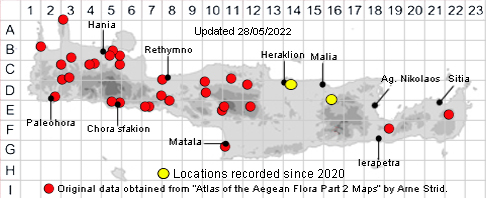

RANUNCULUS CHIUS
Family and Genus:- See- RANUNCULACEAE/Subgen. RANUNCULUS/Sect.
Common Names:- Eastern buttercup
Homotypic Synonyms:- None
Meaning:- Ranunculus (L) Little-frog, diminutive of rana, (reference to the water-
loving habit of many species).
Chius (Gr) From Chios.
General description:- Sparsely soft-pubescent annual, variable in size and habit,
but often branched from the base.
Stems:-
1) 10-30 cm., ascending to erect.
Leaves:-
1) Basal, long-petiolate;
a) lamina, 1.5-4 x 2-5 cm, cordate at the base, shallowly 3 lobed, the lobes with
a few broad, obtuse teeth.
2) Cauline, lower and middle, similar to the basal, the uppermost elliptic-ovate and
subentire.
Flowers:-
1) Small, solitary in the leaf axils, often along most of the stem.
2) Flowering pedicel, suberect, usually shorter than the subtending leaf.
3) Fruiting pedicel, swollen, clavate, recurved.
4) Sepals, ± deflexed, pilose, caducous.
5) Petals, 2-4 mm, elliptic, obtuse, pale yellow, caducous.
6) Receptacle, glabrous.
Fruit:-
1) Achenes,
a) head, globose.
b) body, c. 0.5 x 2.2 mm, compressed, obliquely obovate to suborbicular,
brown, densely covered with short, hooked prickles (rarely smooth), with a
smooth green margin attenuate into a broadly falcate, hooked beak, c. 1.4
mm.
Key features:-
1) Basal leaves, cordate at the base, shallowly 3 lobed.
2) Petals, 2-4 mm, elliptic, obtuse, pale yellow, caducous.
3) Fruiting pedicel, swollen, clavate, recurved.
4) Achene, at most twice as long as the beak. Densely covered with short, hooked
prickles.
Habitat:- In clay by springs and vernal pools, seasonally damp places in dry open
shrubby vegetation, scrubland vegetation, open woodland and olive groves. 0-600(-
1100) m.
Distribution:- Throughout Greece, but rare in the north. - C & E Mediterranean
region, scattered eastwards to Iran. Somewhat limited distribution on Crete, mainly
in the west.
Flowering time:- Late Mar to mid- May.
Photos by:- Fotis Samaritakis
SPECIES DESCRIPTION